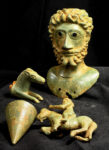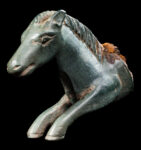 The nationally important hoard of votive bronzes including a bust of Emperor Marcus Aurelius that fell through the loophole in the Treasure Act and were sold at auction earlier this year have been acquired by the Yorkshire Museum. Discovered in 2020 by two metal detectorists near the village of Ampleforth, North Yorkshire, the collection of bronzes includes an equestrian statuette of a local iteration of the god Mars, a knife handle shaped like the forequarters of a horse, a large plumb bob and a finely-modeled bust of Marcus Aurelius six inches high. They date to the late 2nd century.
The nationally important hoard of votive bronzes including a bust of Emperor Marcus Aurelius that fell through the loophole in the Treasure Act and were sold at auction earlier this year have been acquired by the Yorkshire Museum. Discovered in 2020 by two metal detectorists near the village of Ampleforth, North Yorkshire, the collection of bronzes includes an equestrian statuette of a local iteration of the god Mars, a knife handle shaped like the forequarters of a horse, a large plumb bob and a finely-modeled bust of Marcus Aurelius six inches high. They date to the late 2nd century.
Most remarkable is the striking bust of Antonine emperor Marcus Aurelius. This would have sat atop a sceptre or priestly staff, a focal point for religious ceremonies. Being the face of the emperor, it is a potent symbol of the Imperial Cult, the empire-wide worship of emperors as divine. Such direct evidence of the imperial cult is exceedingly rare, especially in rural settings like this. In terms of its execution and style the bust is absolutely unique, exceedingly rare and of great national significance in its own right.
The three objects found alongside the bust help to add context to the burial of this spectacular object. The beautifully detailed horse and rider figure, a localised depiction of the god Mars, is of a type that has never been found this far north. The knife handle in the form of a horse, may symbolically represent a sacrificial animal in this context. The plumb bob is a large and fine example of a functional object used in Roman engineering projects. Its inclusion within the hoard is unparalleled in Roman Britain and hints at the focus of this enigmatic ritual being the blessing of an act of landscape engineering.
 When the assemblage was sold to an unknown buyer for £185,000 ($260,000) in May 2021, I expressed a forlorn hope that the buyer would turn out to be a museum or a generous donor thereto. It was neither. The buyer was antiquities dealer David Aaron, but a generous donor did materialize to save the day. Richard Beleson of San Francisco, a great friend of the Yorkshire Museum who supported them in their acquisition of the Wold Newton Roman coin hoard in 2017, went to the bat for them again. With additional contributions from the Art Fund and other private donors, the museum was able to secure this exceptional treasure that is so uniquely significant to the history of Yorkshire.
When the assemblage was sold to an unknown buyer for £185,000 ($260,000) in May 2021, I expressed a forlorn hope that the buyer would turn out to be a museum or a generous donor thereto. It was neither. The buyer was antiquities dealer David Aaron, but a generous donor did materialize to save the day. Richard Beleson of San Francisco, a great friend of the Yorkshire Museum who supported them in their acquisition of the Wold Newton Roman coin hoard in 2017, went to the bat for them again. With additional contributions from the Art Fund and other private donors, the museum was able to secure this exceptional treasure that is so uniquely significant to the history of Yorkshire.
The hoard was discovered in the Ampleforth area of Ryedale district, North Yorkshire, England. Before the discovery of this hoard, the presence of the Romans in this area was little known. This find therefore rewrites the history of our region. The situation of this discovery, with detailed and reliable provenance information, makes the hoard even more significant.
The hoard is on display this week at the Frieze Masters in London. It will then make a permanent move to York where it will be exhibited in the Yorkshire Museum’s Roman collection when the museum reopens in 2022.